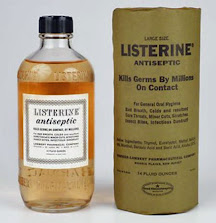J & J opposed an application to register the proposed mark PISSTERINE for non-medicated mouthwash, claiming likelihood of confusion with, and likely dilution of, its registered mark LISTERINE for, inter alia, medicated mouthwash, toothpaste, and dental floss. J & J established that its mark is famous for Section 2(d) purposes. The goods are overlapping or related, but what about the marks? What about parody? Johnson & Johnson v. Pissterine, LLC, Opposition No. 91254670 (January 18, 2022) [not precedential] (Opinion by Judge Jyll Taylor).
Applicant did not dispute that LISTERINE does not describe or suggest any characteristics or qualities of J & J's goods. The inspiration for the term LISTERINE came from an English doctor, Joseph Lister, the first surgeon to perform an operation in a chamber sterilized with antiseptics." The Board found the mark to be arbitrary, inherently distinctive, and conceptually strong.
As to commercial strength, the LISTERINE product has been marketed continuously since 1879. J & J's advertising and sales figures were "quite impressive." The Board found the mark to be famous for oral care products and services.
Turning to the marks, the Board noted that famous marks merit a broader scope of protection than other marks. The Board found the involved marks to be visually similar: one -word terms ending in "ERINE." The other letters "do little to distinguish the marks' appearance."
As to sound, the marks have "the same three-syllable cadence, with a rhyming first syllable and identical following syllables." As to meaning, both marks appear to be arbitrary.
Applicant did not submit any testimony or evidence, nor did it file a brief. In its answer, however, it did raise the issue of parody, claiming no likelihood of confusion and fair use. The Board observed that "Applicant's intention for its mark to be a parody does not necessarily negate a finding of likelihood of confusion." In short, "parody is not a defense if the marks would otherwise be considered confusingly similar." Nike, Inc. v. Maher, 100 USPQ2d 1018, 1023 (TTAB 2011) .
J & J claimed that, under the 13th DuPont factor, the Board should find bad faith on the part of the applicant. The Board, however, pointed out that a parody "by its very nature is an attempt to create an association in the form of an outlandish imitation."
And so, the Board concluded that the applicant's intention to create a parody, by itself, did not evidence an intention to trade on the goodwill of the LISTERINE mark. And so, the Board sustained J & J's Section 2(d) likelihood of confusion claim. It declined to reach the dilution-by-blurring claim.
Read comments and post your comment here.
TTABlogger comment: Do you really think consumers would believe PISSTERINE emanated from, or was licensed or approved by, the source of LISTERINE? I think LISTERINE qualifies as famous for purposes of dilution; a good example of a "household word." The Board should have gone the dilution-by-blurring route. As for dilution-by-tarnishment, better to avoid the potential constitutionality issue there.
The content of this article is intended to provide a general guide to the subject matter. Specialist advice should be sought about your specific circumstances.


